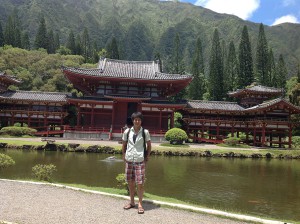ELSI Blog
54 My First Visit to ELSI

I heard about ELSI at quite an early stage of their existence. When I was a third-year undergraduate student (in 2012), I had two information sources, which is interesting enough to be noted because it was still when there was almost no information at all on the Internet or anywhere about ELSI. One source was Professor Kurokawa, a vice director of ELSI, whose laboratory I was already determined to belong to then, and the other was Professor Hirose, the director. Although I was in a different department, I was taking Hirose sensei's earth material science class for the reason that I was simply interested in the subject and that I thought it would be helpful to know this planet well if I were to research on environmental metagenomics. I did not have the slightest idea that those two professors were working together for a new institute then, so it felt as if the two different paths I took had naturally merged into one path towards ELSI.
In the context of this fateful background, I went off track when I started research in Kurokawa & Yamada laboratory, mainly because I was supervised under Yamada sensei rather than Kurokawa sensei. One year passed with no connection with ELSI and just when it was almost buried in oblivion, I heard of a welcoming event being hosted there that was specifically aimed towards introducing the institute to the students of Tokyo Tech. At first I felt there was no reason to attend because I already chose a topic not related to the origin of life, but the merits of curiosity is that there was no reason to decline either.
So I attended the event and I am glad to have been there. There are several reasons that make me think so. First, the place was beautifully arranged. The atmosphere was modern and international, a description that fitted the people there as well. Second, it was clear that ELSI put importance on human networks that bring people of different research backgrounds together. In tackling a big theme like the origin of life, it is almost impossible by the nature of the question to proceed in separate disciplines and fields. It is easy to understand this but hard to implement. What I usually hear about interdisciplinary departments is that the people often remain divided according to their backgrounds. To be honest, I am not sure yet if ELSI is really a perfect platform for interdisciplinary or even trans-disciplinary collaborations, but at least I got an impression that they have a good chance at success. Finally, the faculty and staff were frank and open when talking with the students in a sincere way.
Being at ELSI reminded me of the Okinawa Institute of Science and Technology (OIST), where I visited as a participant of an event this spring. OIST is a newly built, government-funded interdisciplinary graduate school in Okinawa, and the environment it offers is truly international and well-designed in many ways. I remember being surprised at how different it was from Japanese universities. ELSI shares many of the same qualities as what I experienced at OIST. Even though the research targets and the locations of OIST and ELSI are so different that I cannot easily compare except in superficial ways, both of them seem to be making a difference in how interdisciplinary research should be undertaken. It gives me a sense of hope and excitement as an option to the future of Japanese scientific institutes.
These are my thoughts on my first visit to ELSI. I don't know yet how I will interact with ELSI but surely this occasion has inspired me to start thinking about it seriously.











